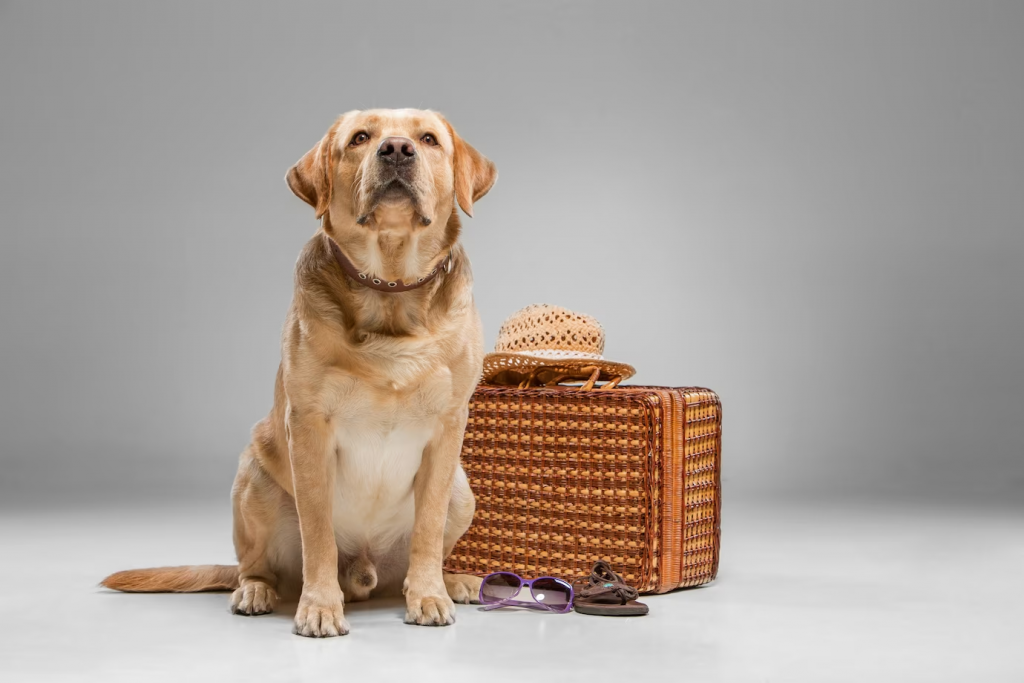Yes. It is getting more and more popular to take fidos traveling abroad. As the best companions, people don’t want to leave their lovely ones at home alone. To ensure a safer trip with dogs entering and leaving their territories, many countries have launched a series of rules and regulations on pet passports under the Pet Travel Scheme.

What is a Pet Travel Scheme?
A Pet Travel Scheme (PETS) is a program that allows pet owners to bring their dogs, cats and ferrets to travel freely between member countries without extra quarantine. It was first launched by the United Kingdom and is now applied in EU countries and the United States. As part of the procedure, a pet passport is a formal document that carries the pet owner’s personal information, the pet’s information and health conditions, such as date of birth, microchipping number, vaccination, etc. Except for Maldives which does not allow dogs to enter, most countries require a pet passport or other certified documents to prove that your dogs are healthy to travel.
Travel Restrictions for a Dog
Immunizations are not uniform in all countries. Requirements for taking dogs to travel might vary from region to region, covering the vaccination types and time, the age of the dog, etc.
For example, dogs traveling to the UK, Ireland, Finland, Norway or Malta must have a tapeworm treatment 24 – 120 hours (1-5 days) before arrival with a “non-commercial” health certificate or 24 – 48 hours (1-2 days) before leaving the US with “commercial” health certificate.
If you are traveling to Austria, dogs must be at least 7 months old while 6 months for the Bahamas, 5 months old for Hong Kong, 4 months for Israel & Thailand, 3 and a half months for Croatia, Netherlands, Latvia, Lithuania, Luxemburg, Germany & Cyprus and 3 months for Italy, Spain, France, Greece, Japan, Malaysia, Denmark, Czech Republic, & Turkey.
How to get a US Pet Passport
To apply for a US pet passport for your dog, you have to do as follows:
Learn about the Requirements
Requirements vary from country to country, so you have to tell the vet about your traveling destination and date. Generally, in order to take your pet for an international trip, you have to learn about the requirements of the country that you are going to and the airline or shipping company that will carry your pet.
The destination’s rules and regulations can be found on USDA website. Then, for further security, we suggest you contact its embassy or consulate to confirm.
As for airlines, cost and boarding requirements might vary from company to company. Please search or contact customer service before booking the ticket.
Visit the Veterinarian
Veterinarians will offer a pet passport after identification, health examination and required vaccination under PETS. Make sure to visit a licensed veterinarian who is certified by the United States Department of Agriculture (USDA). The common process includes implanting the microchip, verifying rabies vaccination, and offering other required treatments.
Get Certification from USDA (If Necessary)
If the veterinarian confirms that your pet is qualified for the trip, he/she will issue a health certificate. That is not the end. Some countries or airlines request USDA endorsement for traveling with pets. Please contact the local USDA veterinary service center and the officers will review the health certificate and other documents and issue the certificate.
General Required Documents
Although the regulations for a US pet passport might differ due to where you go, there are some general requirements applicable to most destinations.
Microchip
It is a rice-size component that is injected under the skin of your pet and responds to radio-frequency identification. The implantation could be done in a vet’s office. Used to retrieve the pet owner’s information, it is necessary in almost all countries when you take it abroad.
Rabies Vaccination
This is a must for your pets and it should be done after implanting the microchip. The required vaccination time is subject to your destination.
For instance, pets younger than 15 weeks old and vaccinated for rabies more than 21 days before entry are not allowed to enter the UK.
EU requires your pets to take a rabies antibody test at least 30 days after vaccination and more than 3 months before traveling. The neutralizing antibody level should be at least 0.5 IU/ml.
Health Certificate
It is issued by veterinarians stating that your pet is in good condition and has taken all necessary vaccinations to travel. According to most US airlines, this certificate should be issued within 10 days before departure.
Additional Vaccinations
Besides vaccination for rabies, there might be extra required vaccinations for diseases like distemper, parvovirus or kennel cough. Please make sure your pet has taken all necessary injections.
Parasite Control
Some countries might require you to show proof of your pet’s protection from parasites, such as fleas, ticks, etc. For example, pets must take anti-tick and anti-tapeworm treatments before entering UK and Ireland.
Import Permits and Government Endorsement
These are designated by certain countries. As we stated before, once they are required, please contact the USDA for further confirmation.
How to Get an EU Pet Passport
An EU Pet Passport refers to the documents that indicate your pet can travel to EU countries without quarantine. How to obtain one depends on where you come from.
Travel Within EU Countries
If you are traveling within the EU, you can visit an official veterinarian or a designated animal health authority where your dog should be implanted with microchips, take rabies vaccination and tapeworm treatment (if necessary). Usually, you have to make an appointment with the vet first. They will give you an application form on which you need to fill in your contact and your pet’s information. Then submit the form and other documents (i.e. health certificate) to the official veterinary regulatory body.
Travel to EU from Non-EU Countries
If you are traveling to the EU outside EU, your pet needs to go through the following process:
- Microchip implantation
- Animal health certificate which should be issued and signed by a certified veterinarian within 10 days before departure and will be valid for travel within EU for 4 months or return to Great Britain in 4 months.
- Rabies blood test is required for visitors from countries with underdeveloped veterinary systems or higher rates of rabies. It should be done at least 30 days after rabies vaccination. You should set out after 3 months after your pet’s blood sample is taken.

Airline Dog Restrictions
When it comes to taking your pets abroad by air, please note that not all airlines accept dogs. There are dog-friendly airlines in the US and you can visit their website to find out details about shipping information, destination restrictions, fees, etc.
Moreover, not all breeds are acceptable considering their physical conditions. Brachycephalic breeds are usually not popular in most airlines because their breathing might be influenced during the flight. And some are not suitable to be shipped in cargo. These are Bulldog (American, French, or English), Cavalier King Charles Spaniel, English Toy Spaniel, Japanese Spaniel, Mastiff (American, South African, BullMastiff, Mallorquin, Italian, Argentinian, French, English, Brazilian, Indian, Neapolitan, Spanish), Tosa, Pekingese, Pug, Shar-Pei, Tibetan Spaniel and Bull Terriers. If you do want to take them with you and they have got a health certificate, you can contact the airline to confirm.
There are mainly 3 ways to ship your pets by air:
- Travel in the cabinet with you. Only dogs and cats are allowed. Carry-on dogs and cats must meet the size, age restrictions and destination policies. For example, according to American Airlines, the hard-sided kennel should be 19 x 13 x 9 inches for Mainline flights on American or 16 x 12 x 8 inches for Regional flights on American Eagle. The Soft-sided kennel is recommended to be 18 x 11 x 11 inches. Also, please contact the reservations support team to verify.
- Book a separate flight for your pet. This is not recommended because it is not a good idea to leave your pet alone and it usually costs more than the excess baggage cargo rate. Many airlines are canceling this service gradually.
- Ship your pet through a commercial shipper. This is similar to registered luggage. You will be charged with cargo rate and an extra fee for the pet shipper. It is a perfect solution for pets that are too big to carry on.
Summary
Except for Maldives which does not permit dog entry, it is necessary to get a pet passport when taking your dogs to travel abroad. In order to make your trip smooth and enjoyable, you should learn about the specific requirements of your destination countries and territories. As a responsible owner, you should always pay attention to the health and well-being of your lovely ones. The key point to obtaining a qualified pet passport is to find a licensed veterinarian, accurate identification, up-to-date vaccinations and a complete health certificate. After these are done, you can start an exciting adventure with your furry friend.